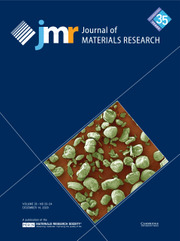Article contents
Synthesis of SrTiO3 nanoparticle/polymer composite film using direct current field
Published online by Cambridge University Press: 31 January 2011
Abstract
Nanocrystalline SrTiO3 particle/polymer composite film was synthesized from a titanium–organic film and strontium ion in aqueous solution by applying a direct current (dc) field. The titanium–organic precursor was synthesized from acetylacetone-modified titanium isopropoxide and a methacrylate derivative. Ultraviolet treatment of the titanium–organic film decreased the leaching of Ti moieties from the precursor film during dc treatment. Crystalline SrTiO3 particles were formed in the precursor films on stainless-steel substrates under a dc field above 40 °C without a high-temperature process. The size of SrTiO3 particles increased with increasing reaction temperature from 40 to 50 °C at 3.0 V/cm. SrTiO3 particles also increased in size with increasing reaction time from 35 to 60 min at 3.0 V/cm and at 50 °C. SrTiO3 particle/polymer films were synthesized on stainless-steel substrates at 3.0 V/cm and 50 °C for 60 min.
Information
- Type
- Articles
- Information
- Copyright
- Copyright © Materials Research Society 2008
References
REFERENCES
- 3
- Cited by

